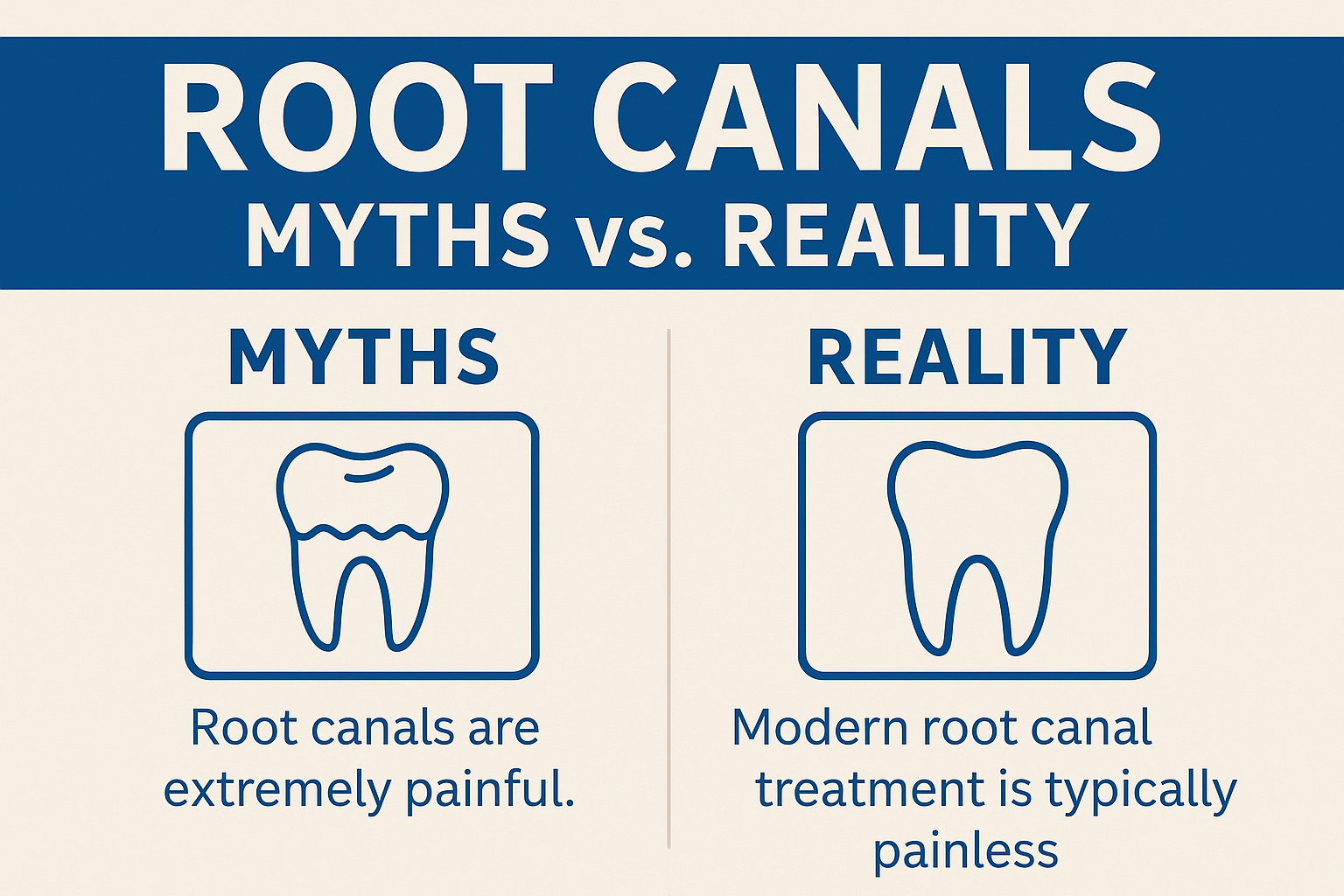
Understanding Root Canal Treatment
What is a Root Canal?
A root canal is a dental procedure designed to save a tooth that is badly decayed or infected. During the procedure, the pulp—the soft area inside the tooth that contains nerves and blood vessels—is removed. The inside of the tooth is then cleaned, disinfected, and sealed.
How Does Endodontic Treatment Work?
The main goal is to eliminate bacteria from the infected root canal, prevent reinfection, and save the natural tooth. It’s often performed in one or two visits using specialized tools and sometimes with the help of dental microscopes or lasers for precision.
Common Root Canal Myths Debunked
Myth 1: Root Canals Are Extremely Painful
Truth: With modern anesthetics and techniques, most patients report that getting a root canal is no more painful than getting a filling.
Myth 2: Root Canals Cause Illness
Truth: Modern science has debunked outdated studies suggesting root canals cause illness. They are safe and effective.
Myth 3: Tooth Extraction is Better
Truth: Preserving your natural tooth through a root canal is usually a better long-term option for function and aesthetics.
Myth 4: Root Canals Don’t Last Long
Truth: With proper care, a root canal-treated tooth can last a lifetime.
Myth 5: You Don’t Need a Root Canal if You’re Not in Pain
Truth: Infections can still spread even if the tooth doesn’t hurt. Regular checkups are essential.
Root Canal Facts You Should Know
Modern Root Canals Are Virtually Painless
Dentists use local anesthesia and advanced tools to make the procedure comfortable.
Success Rate and Longevity
Root canals have a success rate over 95%. With care, treated teeth can last as long as natural ones.
Root Canals Save Natural Teeth
Saving your tooth helps maintain function, alignment, and jaw structure.
Endodontists Are Specialists
These dental professionals are experts in performing root canals and handling complex cases.
What to Expect During the Procedure
Step-by-Step Breakdown
- Examination and X-rays
- Local anesthesia administration
- Drilling an access hole
- Removing infected pulp
- Cleaning and sealing canals
- Placing a restoration, often a crown
Duration and Recovery Time
The procedure takes 1–2 hours. Most people resume normal activities the same day.
Post-Treatment Care and Tips
Managing Pain
Over-the-counter pain relievers usually suffice. Contact your dentist if pain persists.
Oral Hygiene Guidelines
- Brush and floss daily
- Avoid chewing on the treated side until crowned
When to See Your Dentist Again
Attend all follow-up visits to ensure proper healing and restoration.
Benefits of Root Canal Treatment
Preserving Natural Function and Appearance
Your natural teeth provide optimal chewing ability and appearance.
Preventing Jawbone Degeneration
Tooth loss can cause bone loss. Root canals help avoid this issue.
Cost-Effective Compared to Alternatives
Root canals often cost less than extractions followed by bridges or implants.
When Do You Really Need a Root Canal?
Signs and Symptoms
- Persistent toothache
- Sensitivity to temperature
- Discoloration
- Swollen or tender gums
- Recurring pimple on gums
Diagnosis by a Dental Professional
X-rays and clinical tests confirm the need for a root canal.
Are There Alternatives to Root Canals?
Extraction and Dental Implants
Extractions are invasive and may lead to complications. Implants are costlier and more invasive.
Pulp Capping and Other Techniques
Only viable in early-stage decay. Not a long-term solution in most cases.
Root Canal Treatment and Oral Health
Impact on Overall Health
Prompt treatment helps prevent the spread of infection and supports overall health.
Long-Term Dental Health Maintenance
Good hygiene and dental visits ensure the longevity of treated teeth.
Cost and Insurance Coverage
Average Cost
- Front tooth: $700–$1,000
- Premolar: $800–$1,200
- Molar: $900–$2,000
Insurance Coverage
Most plans cover 50%–80%. Contact your provider for exact details.
Pediatric Root Canals: Myths and Truths
Do Children Need Root Canals?
Yes, especially for saving baby teeth and supporting development.
What Parents Should Know
Procedures are simpler for children and typically handled by pediatric dentists.
Technology Advancements in Root Canals
Use of Lasers and Microscopes
Advanced tools help disinfect and visualize canals better for effective treatment.
Improved Materials and Techniques
Modern materials like nickel-titanium files ensure precision and faster recovery.
Patient Experiences and Testimonials
Real Stories from Patients
Many patients find the procedure much easier and more comfortable than expected.
How Root Canals Changed Their Lives
Patients report improved confidence, function, and relief from chronic pain.
FAQs: Common Questions About Root Canals
Is a root canal safe?
Yes. It’s a common, highly successful procedure performed millions of times annually.
How long does a root canal last?
With good care, it can last a lifetime.
Can you eat after a root canal?
Yes, but wait for the numbness to subside and eat soft foods initially.
What happens if you avoid a root canal?
You risk severe infection, abscess, and tooth loss.
How much pain is normal after a root canal?
Mild discomfort is common. Persistent pain should be checked by your dentist.
Can a root canal be redone?
Yes. Retreatments or surgical options like apicoectomy can resolve issues if needed.
Conclusion: Separating Fear from Facts
Why Education is Key to Good Dental Health
Understanding root canal facts helps eliminate fear and leads to better dental decisions.
Speak to Your Dentist
If you’re advised to get a root canal, consult your dentist or endodontist. Modern dentistry makes it a safe, effective way to save your natural teeth.
